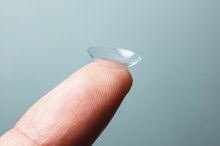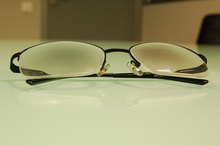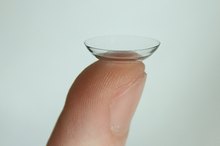What does fact checked mean?
At Healthfully, we strive to deliver objective content that is accurate and up-to-date. Our team periodically reviews articles in order to ensure content quality. The sources cited below consist of evidence from peer-reviewed journals, prominent medical organizations, academic associations, and government data.
- Journal of the Royal Society of Medicine: The Language of Medicine
- Journal of the Royal Society of Medicine: The Language of Medicine
The information contained on this site is for informational purposes only, and should not be used as a substitute for the advice of a professional health care provider. Please check with the appropriate physician regarding health questions and concerns. Although we strive to deliver accurate and up-to-date information, no guarantee to that effect is made.
What Do O.D. & O.S. Stand for on an Eye Exam?
Medicine and law have roots in ancient Rome and use many Latin terms and abbreviations. In ophthalmology, the branch of medicine treating the eye, O.D. and O.S. are commonly used abbreviations referring to the right and left eye.
If you are experiencing serious medical symptoms, seek emergency treatment immediately.
Eye Exam
An eye exam measures vision, evaluating how well a patient can see, both far and near, as well as color and depth perception. During an eye exam, an ophthalmologist or optometrist looks for signs of eye disease and disorders like glaucoma or cataracts. Your doctor assesses each eye separately writes prescriptions for right and left eye.
Latin Terminology
What Do Prescription Numbers Mean in Eye Glasses?
Learn More
When writing eye exam results on a chart or for a prescription, an eye doctor uses the abbreviations for the Latin terms meaning right and left eye. O.D. stands for oculus dexter, or right eye; it means pertaining to the right eye. O.S. means oculus sinister, or left eye. Eye doctors sometimes use the abbreviation O.U, which means both eyes.
- When writing eye exam results on a chart or for a prescription, an eye doctor uses the abbreviations for the Latin terms meaning right and left eye.
- O.D.
- stands for oculus dexter, or right eye; it means pertaining to the right eye.
Reading a Prescription
The terms O.D. and O.S. categorize a prescription for eyeglasses, contacts or therapy. For example, on an eyeglass prescription, numbers under each heading indicate the vision correction needed 2. The further from zero the number is, the stronger the prescription for either the right or left eye. A negative sign indicates that the correction is for nearsightedness; a plus sign means that the correction is for farsightedness.
- The terms O.D.
- and O.S.
- categorize a prescription for eyeglasses, contacts or therapy.
- The further from zero the number is, the stronger the prescription for either the right or left eye.
Latin Lesson
How to Read Contact Lens Power
Learn More
The Latin word meaning left is sinestra, which medical or technical documents sometimes used instead of left handed. At times, left-handedness has had negative connotations, which explains its connection to the word sinister. The Latin word for right-handed is dexter, which is the root of the word dexterity and related to skillful.
Confusion
In 2004, the Joint Commission on Accreditation of Healthcare Organizations (JCAHO) suggested that the abbreviations O.D., O.S 1. and O.U. create confusion and could be mistaken for one another. JCAHO recommended that "right eye," "left eye" and "both eyes" be written in full.
Related Articles
References
- Joint Commission on Accreditation of Healthcare Organizations: "Do Not Use" List
- WebMD: Reading Your Eyeglass Prescription
- Journal of the Royal Society of Medicine: The Language of Medicine
- Dyasanoor S, Urooge A. Insight Into Quality of Prescription Writing - An Instituitional Study. J Clin Diagn Res. 2016;10(3):ZC61–ZC64. doi:10.7860/JCDR/2016/18011.7472
- Weaver JM. It's time to throw out old-fashioned Latin abbreviations. Anesth Prog. 2006;53(1):1–2. doi:10.2344/0003-3006(2006)53[1:ITTTOO]2.0.CO;2
- Velo GP, Minuz P. Medication errors: prescribing faults and prescription errors. Br J Clin Pharmacol. 2009;67(6):624–628. doi:10.1111/j.1365-2125.2009.03425.x
- Sokol DK, Hettige S. Poor handwriting remains a significant problem in medicine. J R Soc Med. 2006;99(12):645–646. doi:10.1258/jrsm.99.12.645
- Thompson CA. JCAHO issues 'do-not-use' list of dangerous abbreviations. Am J Health Syst Pharm. 2003;60(24):2540–2542. doi:10.1093/ajhp/60.24.2540
- Horon K, Hayek K, Montgomery C. Prohibited abbreviations: seeking to educate, not enforce. Can J Hosp Pharm. 2012;65(4):294–299. doi:10.4212/cjhp.v65i4.1160
- Glassman P. Making Health Care Safer II: An Updated Critical Analysis of the Evidence for Patient Safety Practices. Chapter 5. The Joint Commission's “Do Not Use” List: Brief Review (NEW). Rockville: Evidence Reports/Technology Assessments, No. 211, 2013.
- Kuhn, I.F. Abbreviations and acronyms in healthcare: when shorter isn't sweeter. Pediatric Nursing. 2007 Sep-Oct;33(5):392-8.









